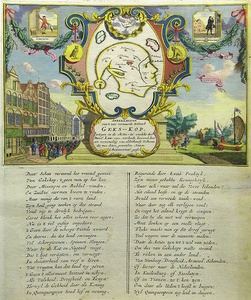| Method | Copper engraving with hand colouring |
| Artist | [Anonymous] |
| Published | Amsterdam, 1720 |
| Dimensions | Image 155 x 226 mm, Plate 159 x 231 mm, Sheet 301 x 248 mm |
| Notes |
This map derives from a series entitled 'Het Groote Tafereel der Dwaasheid,' or 'The Great Mirror of Folly.' Together with Matthaeus Seutter's 'Les Attaques de L'Amour' and Lillian Lancaster's personifications, this satirical engraving of the Mississippi Bubble is one of the most famous cartographic curiosities. The Mississippi Scheme, which came to an end in 1720, was one of the most famous example of a speculative bubble in European history. The scheme was engineered by John Law, a Scottish adventurer, economic theorist, and friend of the Duke d'Orléans. The Compagnie d'Occident, founded by Law in 1717, and spearhead to the vast French territories in the Mississippi River valley of North America, held a complete monopoly over the tobacco and slave trade. By August of 1719, and under the new name of the Compagnie des Indes, Law devised a scheme in which the Mississippi Company subsumed the entire French national debt, and launched a plan whereby portions of the national debt would be exchanged for shares in the company. Based upon the expected riches from the trading monopoly, Law promised an exponential profit for shareholders, and there were at least three-hundred thousand applicants for the fifty-thousand shares offered. As demand for shares continued, the Banque Royale, which was owned by the French government but effectively controlled by Law, continued to print paper banknotes, causing inflation to soar. In May, 1720, the French government acknowledged that the amount of metallic currency in the country was not equal to half the total amount of paper currency in circulation. The value of the shares plummeted, and a general stock market crash ensued in France and its neighbouring countries. By November, shares in the Mississippi Company were worthless, and the company was eventually divested of its remaining assets. John Law was forced to flee the country. In the centre, a map of the island 'Geks-Kop' assumes the form of a man's head in profile wearing the traditional fool's cap. Rivers are used to define the face, the cap, and the jackass's ears, and are marked with the names of those running through towns involved in the speculative schemes of the period. Centrally located is the town of 'Quinquempoix', whilst other smaller locales and harbours are named appropriately. These include Blind fort, Bubble river, and Mad-House. The islets of Sadness, Poverty and Despair surround the head. The map rests on a pedestal bearing a cartouche with the title. On the left, is a view of the rue Quinquempoix in which a crowd throws stones at the headquarters of the Compagnie. To the right, two creditors chase John Law who is seated in a chariot with sails, and heading for Vianen. Inscription content: Title continues to read: 'Gelegen in de Actie-zé, ontdekt door Monsr Lau-rens, werdende bewoond door een verzameling van alderhande Volkeren, die men déze generále Naam (Actionisten) geeft.' This looslely translates as '...lying in the sea of shares, discovered by Mr. Law-rens, and inhabited by a collection of all kinds of people, to whom are given the general name shareholders.' Some engraved Dutch verse features on a second plate located below. BM Satires 1682, Muller 3592 Condition: Generally very good. Repaired tear to the right hand-side of the sheet and light spotting to bottom of the sheet, but in both cases the image is unaffected. Light toning to the right side of the sheet. |
| Framing | unmounted |
| Price | £680.00 |
| Stock ID | 30670 |

